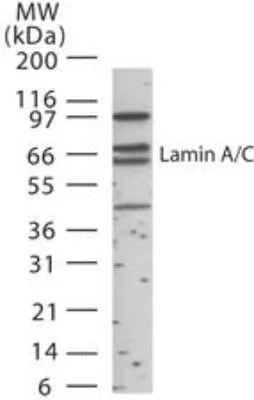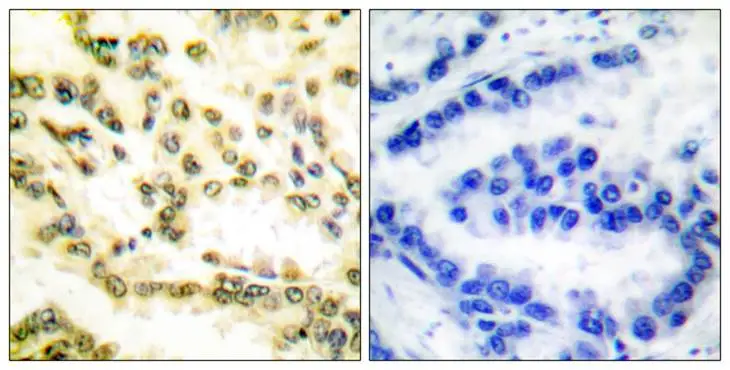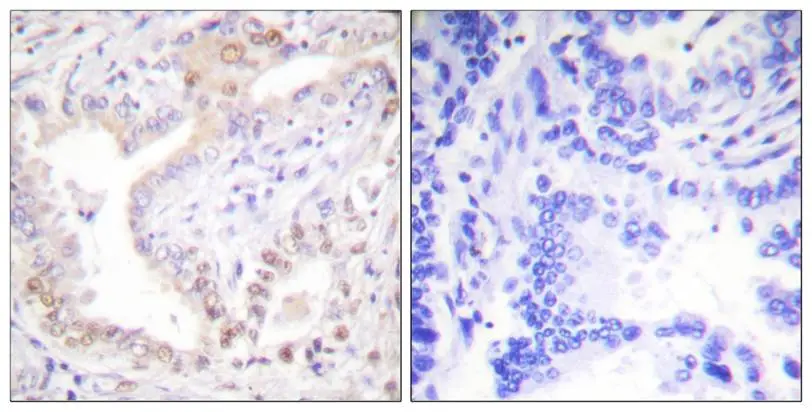Lamin A + C antibody
GTX101127
ApplicationsImmunoFluorescence, ImmunoPrecipitation, Western Blot, ImmunoCytoChemistry, ImmunoHistoChemistry, ImmunoHistoChemistry Paraffin
Product group Antibodies
TargetLMNA
Overview
- SupplierGeneTex
- Product NameLamin A + C antibody
- Delivery Days Customer9
- Application Supplier NoteWB: 1:500-1:3000. ICC/IF: 1:100-1:1000. IHC-P: 1:100-1:1000. IP: 1:100-1:500. *Optimal dilutions/concentrations should be determined by the researcher.Not tested in other applications.
- ApplicationsImmunoFluorescence, ImmunoPrecipitation, Western Blot, ImmunoCytoChemistry, ImmunoHistoChemistry, ImmunoHistoChemistry Paraffin
- CertificationResearch Use Only
- ClonalityPolyclonal
- Concentration0.16 mg/ml
- ConjugateUnconjugated
- Gene ID4000
- Target nameLMNA
- Target descriptionlamin A/C
- Target synonymsCDCD1, CDDC, CMD1A, CMT2B1, EMD2, FPL, FPLD, FPLD2, HGPS, IDC, LDP1, LFP, LGMD1B, LMN1, LMNC, LMNL1, MADA, PRO1, lamin, 70 kDa lamin, epididymis secretory sperm binding protein, lamin A/C-like 1, lamin C, mandibuloacral dysplasia type A, prelamin-A/C, progerin, renal carcinoma antigen NY-REN-32
- HostRabbit
- IsotypeIgG
- Protein IDP02545
- Protein NamePrelamin-A/C
- Scientific DescriptionThe nuclear lamina consists of a two-dimensional matrix of proteins located next to the inner nuclear membrane. The lamin family of proteins make up the matrix and are highly conserved in evolution. During mitosis, the lamina matrix is reversibly disassembled as the lamin proteins are phosphorylated. Lamin proteins are thought to be involved in nuclear stability, chromatin structure and gene expression. Vertebrate lamins consist of two types, A and B. Alternative splicing results in multiple transcript variants. Mutations in this gene lead to several diseases: Emery-Dreifuss muscular dystrophy, familial partial lipodystrophy, limb girdle muscular dystrophy, dilated cardiomyopathy, Charcot-Marie-Tooth disease, and Hutchinson-Gilford progeria syndrome. [provided by RefSeq, Apr 2012]
- Storage Instruction-20°C or -80°C,2°C to 8°C
- UNSPSC12352203
References
- Targeting BRD3 eradicates nuclear TYRO3-induced colorectal cancer metastasis.Read more
- A G-quadruplex stabilizer, CX-5461 combined with two immune checkpoint inhibitors enhances in vivo therapeutic efficacy by increasing PD-L1 expression in colorectal cancer.Read more
- CD44 Promotes Breast Cancer Metastasis through AKT-Mediated Downregulation of Nuclear FOXA2.Read more
- TFEB- and TFE3-dependent autophagy activation supports cancer proliferation in the absence of centrosomes. Kao CH et al., 2022 Dec, AutophagyRead more
- Relevance of AIF/CypA Lethal Pathway in SH-SY5Y Cells Treated with Staurosporine. Conte M et al., 2021 Dec 27, Int J Mol SciRead more
- 8-Hydroxydaidzein Downregulates JAK/STAT, MMP, Oxidative Phosphorylation, and PI3K/AKT Pathways in K562 Cells. Wu PS et al., 2021 Dec 14, BiomedicinesRead more
- FJU-C28 inhibits the endotoxin-induced pro-inflammatory cytokines expression via suppressing JNK, p38 MAPK and NF-kappaB signaling pathways. Jung F et al., 2021 Dec, Pharmacol Res PerspectRead more
- MTHFR Knockdown Assists Cell Defense against Folate Depletion Induced Chromosome Segregation and Uracil Misincorporation in DNA. Wu MT et al., 2021 Aug 30, Int J Mol SciRead more
- Etoposide Triggers Cellular Senescence by Inducing Multiple Centrosomes and Primary Cilia in Adrenocortical Tumor Cells. Teng YN et al., 2021 Jun 11, CellsRead more
- Arginine starvation elicits chromatin leakage and cGAS-STING activation via epigenetic silencing of metabolic and DNA-repair genes. Hsu SC et al., 2021, TheranosticsRead more



![ELISA analysis of antigen using GTX60478 Lamin A antibody [4E7]. Red : Control antigen 100ng Purple : Antigen 10ng Green : Antigen 50ng Blue : Antigen 100ng](https://www.genetex.com/upload/website/prouct_img/normal/GTX60478/GTX60478_20170912_ELISA_w_23061123_126.webp)
![ICC/IF analysis of H9C2 cells using GTX00774 Lamin A + C antibody [GT1137]. Green: Primary antibody Blue: DAPI Dlution : 1:200](https://www.genetex.com/upload/website/prouct_img/normal/GTX00774/GTX00774_20191101_AP_002_17_w_23053121_128.webp)

